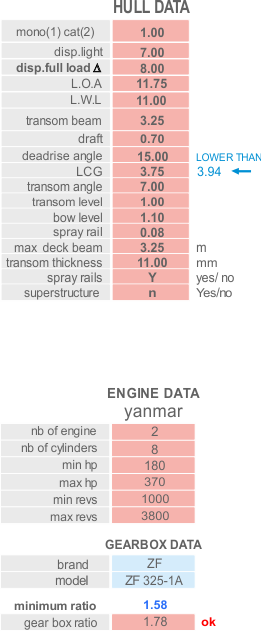Information that is necessary to select an appropriate drive
In order to select an appropriate drive, it is necessary to adopt a holistic approach, taking into account the operating environment, as well as hull, engine and gear unit data.

Type of hull – monohull (single), catboat or trimaran; each of these hulls has a different influence on hydrodynamic resistance and stability.
Displacement , weight – a very important coefficient determining the power of drive units. It is necessary to precisely specify the basic and maximum weight. Underestimating the weight is the most frequent cause of not obtaining the assumed performance of the boat due to a simple relation: the higher the weight, the higher the resistance and hence the lower the speed.
LOA, LWL, BEAM – length overall, waterline length, transom beam. These dimensions have an influence on resistance and speed. The longer the hull, the faster and more stable it is at rough sea.
Draft – another important element influencing total resistance of the boat and the possibility of using SDS (propellers must work in free water flow)
Deadrise angle – the angle specifying the shape of the bottom of the boat. The wider it is (as V-type hull), the higher the resistance and the later the moment of planing.
LCG – centre of gravity has an influence on the behaviour of the hull – its inappropriate location is responsible for chain walking of the boat or riding a high bow.
Transom angle – to check the right arrangement of SDS
Spray rails – they direct the water flow along the hull, reducing resistance
Transom thickness – determines SDS solutions
Steps or no steps – a correctly designed stepped hull reduces the “wet” part of the hull in planing, which reduces resistance and increases speed
Operating environment – performance is also affected by such factors as water salinity and pollution (the higher it is, the higher the resistance). Also important is the sea status at which the boat is to operate: only at 0 or 1 (flat) or 2, 3. Another factor is temperature range of the air or water (how much power is lost to cool the engines).
Selection of engines and gearboxes – we require specifying the number of engines and their parameters. It seems that the higher the power, the better the performance. It is often forgotten, however, that using engines with a higher power entails a significant increase in the weight of the engines. For example, Volvo D3 220 kM weighs 300 kg, and D4 260 kM (300 kM) as much as 550 kg: in a double installation, this is already 500 kg more. There are exceptions to this rule in our offer – V8 diesel engines – VGT 350 kM to 500 kM, which weigh 500 kg. Apart from engine power, the crucial factor is the torque and its availability at consecutive engine rotation speeds. This is why we ask the client every time about the purpose of the boat.
Share: